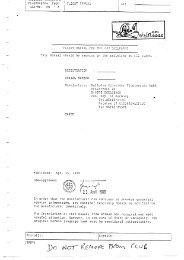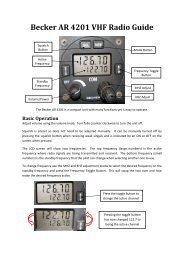SCHEMPP-HIRTH FLUGZEUGBAU GmbH
SCHEMPP-HIRTH FLUGZEUGBAU GmbH
SCHEMPP-HIRTH FLUGZEUGBAU GmbH
You also want an ePaper? Increase the reach of your titles
YUMPU automatically turns print PDFs into web optimized ePapers that Google loves.
<strong>SCHEMPP</strong>-<strong>HIRTH</strong> <strong>FLUGZEUGBAU</strong> <strong>GmbH</strong>., KIRCHHEIM/TECK<br />
Duo Discus FLIGHT MANUAL<br />
Emergency landing with retracted undercarriage<br />
An emergency landing with the main wheel retracted is on principle not<br />
recommended, because the potential energy absorption of the landing gear<br />
is many times higher as compared to the fuselage shell.<br />
Should the wheel fail to extend, the sailplane should be landed at a flat angle<br />
and without pancaking.<br />
Ground loop<br />
If there is the danger of the sailplane overshooting the boundary of the<br />
landing field in mind, a decision whether or not to initiate a controlled ground<br />
loop should be made at least about 40 m (131 ft) away from the boundary:<br />
- If possible, always turn into the wind<br />
and<br />
- as the wing tip is forced down, push the control stick forward simultaneously.<br />
Emergency water landing<br />
From experience gained on the occasion of a composite sailplane landing on<br />
water with its undercarriage retracted, the crew must take into consideration<br />
that, in the case of the “Duo Discus”, the entire cockpit might get forced<br />
under water.<br />
Therefore an emergency landing on water should only be chosen as a last<br />
resort and the main wheel should always be extended.<br />
October 2007 LBA-app.<br />
Revision -- 3.9.2




